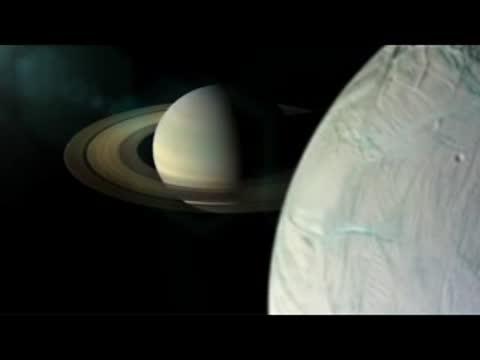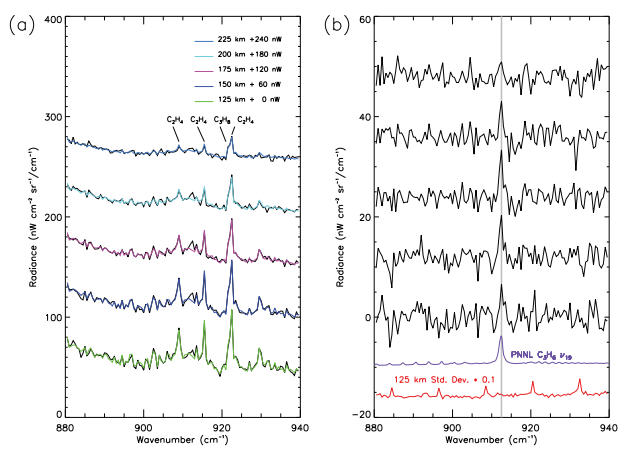Propylene, a chemical used to make food-storage containers, car bumpers and other consumer products, has been detected on Saturn's moon Titan, the first definitive detection of the plastic ingredient on any moon or planet besides ours.
The propylene was identified in Titan's lower atmosphere by Cassini's Composite Infrared Spectrometer (CIRS), which measures the infrared light emitted from Saturn and its moons in much the same way our hands feel the warmth of a fire.
CIRS can identify a particular gas glowing in the lower layers of the atmosphere from its unique thermal fingerprint. The challenge is to isolate this one signature from the signals of all other gases around it.
Propylene is the first molecule to be discovered on Titan using CIRS. By isolating the same signal at various altitudes within the lower atmosphere, researchers identified the chemical with a high degree of confidence. The detection of the chemical fills in a mysterious gap in Titan observations that dates back to NASA's Voyager 1 spacecraft and the first-ever close flyby of this moon in 1980.

Scientists have known about the presence of atmospheric hydrocarbons on Titan since Voyager 1 flew by in 1980, but one molecule, propylene, was curiously missing. Now, propylene has been detected for the first time on Titan. Credit: NASA SVS
Voyager identified many of the gases in Titan's hazy brownish atmosphere as hydrocarbons, the chemicals that primarily make up petroleum and other fossil fuels on Earth.
On Titan, hydrocarbons form after sunlight breaks apart methane, the second-most plentiful gas in that atmosphere. The newly freed fragments can link up to form chains with two, three or more carbons. The family of chemicals with two carbons includes the flammable gas ethane. Propane, a common fuel for portable stoves, belongs to the three-carbon family.
Voyager detected all members of the one- and two-carbon families in Titan's atmosphere. From the three-carbon family, the spacecraft found propane, the heaviest member, and propyne, one of the lightest members. But the middle chemicals, one of which is propylene, were missing.
"This chemical is all around us in everyday life, strung together in long chains to form a plastic called polypropylene," said Conor Nixon, a planetary scientist at NASA's Goddard Space Flight Center in Greenbelt, Md., and lead author of the paper. "That plastic container at the grocery store with the recycling code 5 on the bottom -- that's polypropylene."

(a) The five spectral averages of Titan limb data (black) and the best-fit model spectra (colors), as described in the text. Data/model spectral pairs at each altitude have been vertically offset in radiance for clarity (see legend). (b) the ‘residual’ emission not modeled (black), formed by subtracting data–model spectra. Residuals at each altitude are sequentially offset by 12 nW from the next lower altitude. The purple line is the 278 K laboratory absorbance spectrum of propene for comparison (not in radiance units), showing the location of the ν19 band at 912.5 cm−1. The red line shows the standard deviation of the spectral average at 125 km (others are similar), scaled by ×0.1 and -20 nW offset, showing that the locations of noise artifacts (vertical ‘spikes’) are not coincident with the propene ν19 emission. Credit: arXiv:1309.4489
As researchers continued to discover more and more chemicals in Titan's atmosphere using ground- and space-based instruments, propylene was one that remained elusive. It was finally found as a result of more detailed analysis of the CIRS data.
"This measurement was very difficult to make because propylene's weak signature is crowded by related chemicals with much stronger signals," said Michael Flasar, Goddard scientist and principal investigator for CIRS. "This success boosts our confidence that we will find still more chemicals long hidden in Titan's atmosphere."
Cassini's mass spectrometer, a device that looks at the composition of Titan's atmosphere, had hinted earlier that propylene might be present in the upper atmosphere. However, a positive identification had not been made.
"I am always excited when scientists discover a molecule that has never been observed before in an atmosphere," said Scott Edgington, Cassini's deputy project scientist at NASA's Jet Propulsion Laboratory (JPL) in Pasadena, Calif. "This new piece of the puzzle will provide an additional test of how well we understand the chemical zoo that makes up Titan's atmosphere."
Preprint: Conor A. Nixon, Donald E. Jennings, Bruno Bezard, Sandrine Vinatier, Nicholas A. Teanby, Keeyoon Sung, Todd M. Ansty, Patrick G. J. Irwin, Nicolas Gorius, Valeria Cottini, Athena Coustenis, F. Michael Flasar, 'Detection of Propene in Titan's Stratosphere', arXiv:1309.4489
Citation: Conor A. Nixon, Donald E. Jennings, Bruno Bezard, Sandrine Vinatier, Nicholas A. Teanby, Keeyoon Sung, Todd M. Ansty, Patrick G. J. Irwin, Nicolas Gorius, Valeria Cottini, Athena Coustenis, F. Michael Flasar, 'Detection of Propene in Titan's Stratosphere', The Astrophysical Journal Letters Volume : 776 Issue Num 1 doi:10.1088/2041-8205/776/1/L14






Comments